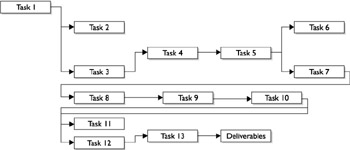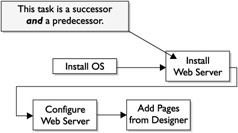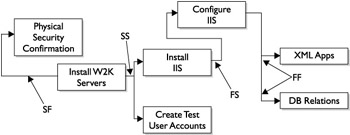Creating a Project Network Diagram
Recall that a WBS is a topology of the project deliverables. A WBS takes the project and breaks the project down into major components. These components can then be broken down again into other components , then again into work packages, and, finally, documented with a task list that is derived from the WBS. Once the WBS has been created, the activity list can then be entered into Microsoft Project, or your favorite Project Management Information Systems (PMIS) software . Once you enter the activities into Microsoft Project, you can create a Gantt chart like the one in Figure 7-2. It shows a mapping of each of the units of work required to complete each phase of the project.

Figure 7-2: A WBS decomposed the project into similar, accessible work units.
The Gantt chart is ideal for simple, short- term projects. It is a timeline of the events with consideration given to tasks that can be completed concurrently within a project s lifespan. Traditional Gantt charts have some drawbacks:
-
Gantt charts do not display detailed information on each work unit. (Microsoft Project does allow project managers to add task information and notes within a Gantt chart on each task.)
-
Gantt charts only display the order of tasks.
-
Gantt charts do not clearly reflect the order of tasks in multiple phases.
-
Gantt charts do not reflect the shortest path to completion.
-
Gantt charts do not reflect the best usage of resources.
To address these issues, project managers can use a Project Network Diagram (PND). PNDs are a fluid mapping of the work to be completed. Figure 7-3 is a sample of a portion of a network diagram. Incidentally, the terms PND, Project Network Diagrams, and network diagrams all refer to the same workflow structure ”don t let the different names confuse you. Such diagrams allow the project manager and the project team to tinker with the relationships between tasks and create alternative solutions to increase productivity, profitability, and the diligence of a project.

Figure 7-3: Network diagrams demonstrate the relationship between tasks.
A PND visualizes the flow of work from conception to completion. Network diagrams provide detailed information on work units and allow project managers to analyze tasks, resources, and the allotted time for each task. You can use a PND to determine the flow of work to predict the earliest completion date. Network diagrams are ideal for these situations:
-
Detailed project planning In large projects that may span several months, or even years , a network diagram is essential as it can correlate each task in relation to the project scope. Through a network diagram, the project manager, management, and the project team can see the entire project plan from a high-level view, and then zoom in on a specific portion of the project plan.
-
Implementation tracking As tasks are completed on time, or over time, the number of time units used can accurately display the impact on dependent tasks within the project. If you use software to track the project implementation, the reflection of the impact is automated for you. Imagine a task that has four dependencies and the task is two weeks late in completion. The failure of the task to be completed on time now pushes the dependent tasks back by two weeks. A network diagram can illustrate this impact and allow the project manager to react to the changes by adjusting resources or other dependent tasks.
-
Contingency plans Network diagrams allow a project manager to play out what if? scenarios with any work unit within the project plan. A project manager can adjust units of time to see the impact of the work units on the entire project. For example, it may be obvious to see an impact on dependent tasks when a work unit is two weeks late, but what about units that are completed early? Imagine that pay incentives are based on project completion dates ”a series of work units that each have one day shaved off their target completion times may have positive impacts on all future tasks.
-
Resource control A network diagram shows the flow of work and the impact of the finished tasks on the rest of the project. By utilizing the Gantt chart s assigned resources to a unit of work, a project manager can add or remove resources to a task to complete it faster or delay the completion. Resources can be both workers and physical objects such as a bandwidth, faster computers, and leased equipment.
Utilizing the Precedence Diagramming Method
You could start the PND by mapping out work units on a whiteboard, like you did for the WBS ”which is a fine method. However, rather than creating a flat timeline of activity, project managers can use the Precedence Diagramming Method to create a fluid project structure. This sophisticated approach stems from the 1950s, when the original concept was called the activity-on-the-arrow ( AOA ) method. As you can see in Figure 7-4, each arrow represents a task in the project. The origin of the arrow is the begin activity sign, and the end of the arrow is the end activity sign.

Figure 7-4: The AOA method uses arrows to represent the start and end of activities.
As you can imagine, this representation of a project, especially a large project, could prove very cumbersome, as project managers can only have very simple relationships between tasks. What replaced the AOA method is the activity-on-the-node ( AON ) method. With the AON method, the focus is on the activities rather than on the start and end of activities.
This methodology of creating a network diagram is also called the Precedence Diagramming Method ( PDM ). PDM requires the project manager to evaluate each work unit and determine which tasks are its successors and which tasks are its predecessors. Once this information is obtained, you can begin to snap the pieces of the PDM puzzle together. You must give careful consideration to the placement of each task, as all tasks are connected even if they are scheduled to run concurrently.
Each unit of work in a network diagram using PDM is represented by a rectangle called the activity node . Predecessors are linked to successors by arrows, and are always upstream from successors, as Figure 7-5 demonstrates . One work unit can be both a successor and a predecessor; for example, the task to install and configure a web server may first require the installation of an operating system; only after the web server task is complete can the web pages the web server will host be added.

Figure 7-5: Arrows link predecessor and successor tasks using AON.
To begin creating the network diagram using PDM, a project manager will have to determine the order of tasks to be completed. Basically, a project manager asks, What tasks must be completed before the next tasks can begin? The activity list, which you derived from your WBS work packages, is what you are sequencing. You do not want activities that are too short in length to be useful. Based on your project, you may have work units that last days or weeks ” generally not hours.
A rectangular box represents each individual task within the network diagram. As you add tasks to the network diagram, draw an arrow between tasks to connect them in the successor/predecessor relationship. As expected, the network diagram is read left to right, top to bottom. Each task within the diagram must have a successor and predecessor ”except for the first and last task in the project. Once the diagram has been completed with successor and predecessor tasks, it is considered a connected network. A project manager, or anyone involved in the project, can trace any activity through the network.
The relationship between activities is what allows a project to move forward or to wait for other tasks to complete. An accurate description between tasks is required for the project manager to analyze and make adjustments to each task in the network diagram. Figure 7-6 shows the dependency types you may have between tasks. There are four types of dependencies:

Figure 7-6: Dependencies describe the relationship between tasks.
-
Finish to start (FS) This relationship is the most common. It simply requires the predecessor task to complete before the successor task can begin. An example is installing the network cards before connecting PCs to the Internet.
-
Start to start (SS) These tasks are usually closely related in nature and should be started but not necessarily completed at the same time. An example is planning for the physical implementation of a network and determining each network s IP addressing configurations. Each are closely related and can be done in tandem.
-
Finish to finish (FF) These tasks require that the predecessor task and the successor task be completed at the same time. An example is rolling out a new software package and finishing the user training sessions. While users are in the new training session, the new software should be installed and configured on their workstations by the time the training session ends.
-
Start to finish (SF) These rare tasks require that the predecessor doesn t begin until the successor finishes. You won t find yourself using this activity all that often. It s often used with just-in-time scheduling for inventory and manufacturing instances. For example, if you re opening a coffee shop, you ll want your inventory of coffee to be on hand as close as possible to when the construction of your shop is done. The coffee has to be ordered to officially open the shop, and the construction has to be done before you can open the doors. You ll need to time the order of coffee with the completion of the construction in order to open your doors on time without your merchandise spoiling ”or tying up your cash flow in inventory that s not being sold.
EAN: 2147483647
Pages: 195